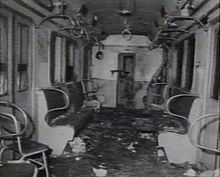Non-fatal injuries 37 Start date January 8, 1977 Attack type Bomb | Perpetrators Unknown Total number of deaths 7 | |
 | ||
Similar 2010 Moscow Metro bo, February 2004 Moscow, Esenboğa International Airport att, Korean Air Lines Flight 007, 2004 Russian aircraft bo | ||
1977 moscow bombings
The 1977 Moscow bombings were a series of three bombings in Moscow committed on January 8, 1977. These terrorist attacks claimed seven lives, while 37 people were seriously injured. No one ever claimed responsibility for the bombing, though three members of an Armenian nationalist organization were ultimately executed for it after a secret trial following a KGB investigation. Some Soviet dissidents claimed that the suspects had an alibi, and Andrei Sakharov believed the bombings might have been arranged by the KGB itself. According to historian Jay Bergman, "who actually caused the explosion has never been determined conclusively".
Contents
Bombings
On January 8, 1977, three explosive devices detonated in Moscow. The first bomb went off at 17:33 on a crowded train between the Izmailovskaya and Pervomaiskaya stations of the Moscow Metro. At 18:05, a second bomb detonated inside the grocery store close to KGB headquarters. Five minutes later the third bomb exploded near yet another grocery store on the 25th of October Street, just a few hundred meters away from Soviet Communist Party headquarters. On February 8, 1977, Izvestia, an official newspaper of the Soviet government, reported that the attacks had resulted in seven deaths and 37 injuries.
Investigation
The official investigation was conducted by the KGB, rather than the Moscow police. An initial suspect, named Potapov, was arrested in Tambov after setting off an explosive device which killed his neighbour's wife and two daughters. After being arrested, Potapov confessed that he was also behind the acts of terrorism in Moscow. However, this turned out to have been a forced confession, and after an investigation lasting one month, this lead was dropped by KGB operatives.
In October 1977, alleged proof of Armenian involvement was received. At the Tashkent Airport, a KGB officer noticed a woman carrying a bag similar to the one in the reconstructed picture of the explosive device sent out by the KGB to all local branches. It turned out that these bags were manufactured only in Yerevan. In November 1977 Stepan Zatikyan, a founding member of a splinter group of the National United Party, an underground Armenian nationalist organization, was arrested. His accomplices Zaven Bagdasaryan and Hakop Stepanyan were also taken into custody after an unsuccessful attempt to detonate an explosive device at the Kursky Rail Terminal in Moscow. A secret trial followed; Zatikyan, Stepanyan, and Bagdasaryan were all found guilty on January 24 and executed five days later. The Soviet press published only one article about the bombings, naming Zatikyan alone as the perpetrator. According to KGB general Philip Bobkov, any publications in Armenia were blocked by Karen Demirchyan, the head of Soviet Armenia.
Alleged fabrication by the KGB
Soon after the bombings, Soviet journalist Victor Louis (Vitaly Yevgenyevich Lui), a well known KGB agent provocateur, published an article about the involvement of Soviet dissidents in the bombings. After learning about this article, Andrei Sakharov wrote an "Appeal to world community", in which he requested an impartial investigation and suggested that the bombings might have been arranged by the KGB itself to discredit the entire Soviet dissident movement. He stated: "I have serious grounds for concern. This is the provocation article in London Evening News by Victor Lui. These are arrests and interrogations of people who are clearly not related to the bombings. These are murders of last months, probably committed by the KGB which were not investigated. It is enough to mention only two of them: murder of poet Konstantin Bogatyrev and murder of lawyer Evgeni Brunov." After this statement, Sakharov was not only attacked in Soviet newspapers but also received threats by phone. Several people tried to break into his apartment, claiming to be relatives of those killed in the Metro.
On February 1, 1979, the Moscow Helsinki Group made an official statement "On the execution of Stepan Zatikyan and two other unnamed individuals", which concludes: "The lack of transparency and the whole atmosphere of secrecy give reasons to doubt the validity of charges, objectivity and impartiality of the court".
According to Soviet dissident Alexander Tarasov, he was indeed interrogated by a KGB investigator at this time. The KGB investigator tried to "convince" him that it was actually him who brought the bomb. Unless "I had 300% alibi" (he was confined at a hospital at the time of the bombings), "it would be me who was executed instead of Zatikyan", he said.
According to former KGB colonel Oleg Gordievsky, the three Armenians were selected as scapegoats for this terrorist act. He wrote:
"The case that most alarmed the KGB was the bombing of the Moscow subway by Armenian separatists in 1977. Three Armenians were later shot. It was rumored in the Center that, when the KGB and militia failed to track down those responsible, three other Armenian separatists had been selected as scapegoats in order to demonstrate that terrorists would always be caught and punished."
According to historians Michel Heller and Alexander Nekrich, Zatikyan, Stepanyan, and Bagdasaryan had an alibi supported by multiple witnesses, and their execution was the first political execution in the Soviet Union after the death of Stalin.
The Armenian dissident Sergei Grigoryants claims that chief of KGB Yuri Andropov and Philipp Bobkov were responsible for the bombing.
